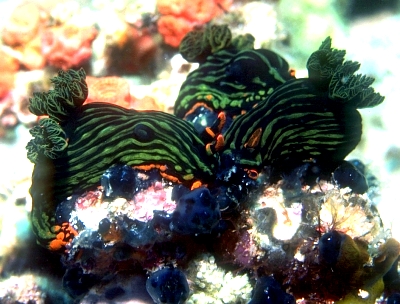
Nembrotha kubaryana
Bergh, 1877
Order: NUDIBRANCHIA
Suborder: DORIDINA
Superfamily: ANADORIDOIDEA
Family: Polyceridae
Subfamily: Nembrothinae
DISTRIBUTION
Tropical Indo-West Pacific
PHOTO
Upper right: Striped form feeding on ascidians [Sigillina signifera ] Apos Is, Negros Is, Philippines, 30m. March 1983. Photo: B. E. Picton. Lower left: red-spotted form, Kendrew Is, Dampier Archipelago, Western Australia. Photo: Clay Bryce. Lower right: green-spotted form, North East Orpheus Is, North Queensland, April 1985. Photo: Bill Rudman.
This relatively large species, sometimes growing more than 120 mm long, shows a considerable range in colour. Essentially black with green pustules, or green longitudinal ridges, there is a bright orange border to the foot and the rhinophore pockets and also around the oral lappets. In some specimens the rhinophores and gills have orange markings but in others, these are green. In some animals the green markings can be replaced by pinkish orange spots or elongate marks.
This species feeds on ascidians. A similarly coloured species, Nembrotha cristata lacks the orange border to the foot.
Some years ago Prof. Valerie Paul and associates (1990) reported on this species and Nembrotha cristata feeding on the ascidian Atapozoa sp. Both species removed antifeedant compounds from the ascidian and stored them in their own bodies, exudung them in a slimy mucus when disturbed for their own defence. [N. kubarayna has also been reported feeding on another dark blue ascidian which has been identified as Sigillina signifera. Perhaps Atapozoa is another name for Sigillina. I need to find an ascidian expert.]
Recently (Pola et al, 2008) have proposed that N. nigerrima and N. kubaryana, which were proposed simultaneously by Bergh (1877), should be synonymised under the name N. nigerrima, but as I discuss [message #21407] and Pola et al accept [message #21417 ], Yonow & Hayward (1991) have already chosen N. kubaryana as the senior synonym so that is the valid name under the International Code..
- Bergh, L.S.R. (1877). Malacologische Untersuchengen. In C.G. Semper, Reisen im Archipel der Philippinen, Wissenscaftliche Resultate, 11: 429-494, pls 54-57
- O'Donoghue, C. H. (1924) Report on Opisthobranchiata from the Abrolhos Islands, Western Australia, with description of a new parasitic copepod. Journal of the Linnean Society, London 35: 521-579, Pls.27-30.
- Paul, V.J., Lindquist, N., Fe n i c a l, W. (1990) Chemical defenses of the tropical ascidian Atapozoa sp. and its nudibranch predators Nembrotha spp. Marine Ecology Progress Series, 59: 109-118
- Pola, M., Cervera, J.L. and Gosliner, T.M. 2008. Revision of the Indo-Pacific genus Nembrotha (Nudibranchia: Dorididae: Polyceridae), with description of two new species. Scientia Marina 72(1): 145-183.
-
Yonow, N. & Hayward, P.J. (1991) Opisthobranches de l'Ile Maurice, avec la description de deux especes nouvelles (Mollusca: Opisthobranchia). Revue francaise d'aquariologie, 18(1): 1-30, Figs 1-13.
Note added 2 March 2008: This is an updated and expanded version of the original Fact Sheet.
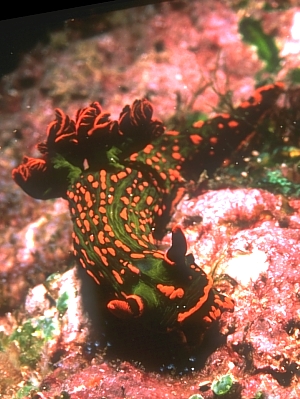
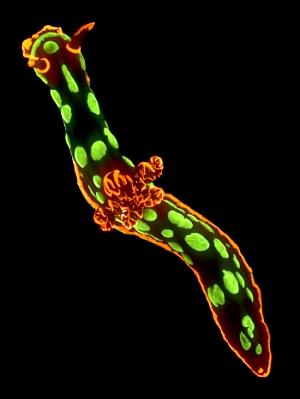
Rudman, W.B., 2008 (March 2) Nembrotha kubaryana Bergh, 1877. [In] Sea Slug Forum. Australian Museum, Sydney. Available from http://www.seaslugforum.net/find/nembkuba
Related messages
Nembrotha feeding habits
December 10, 2009
From: Sula Corbet
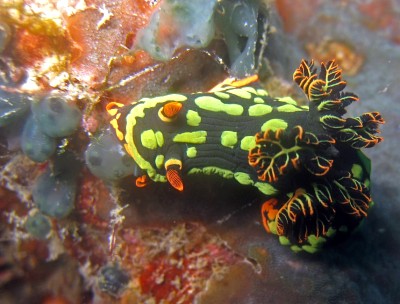
I noticed a discussion on the forum regarding the differences in feeding habits of Nembrotha kubaryana versus N. cristata [message #20385] and thought you might be interested in these photos. The N. cristata [lower photo] was taken on the same day but at a different dive site: Soyak Island, Tioman, Malaysia.
Locality: Batu Malang, Tioman Island, 12 metres, Malaysia, South China Sea, 20 August 2009. Length: ?. Photographer: Sula Corbet.
Sula
sulacorbet@hotmail.com
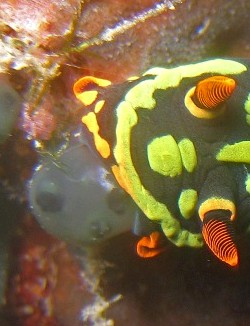
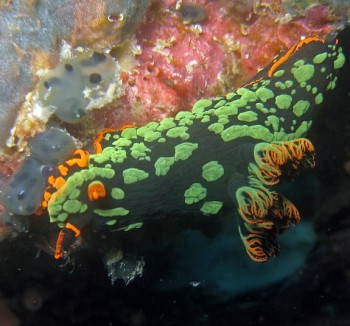
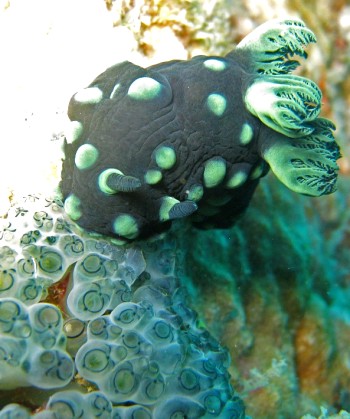
Thanks Sula,
Every bit of information we can accumulate on their feeding is valuable
Best wishes,
Bill Rudman
Nembrotha kubaryana from Exmouth, Western Australia
April 3, 2008
From: Bruce Potter
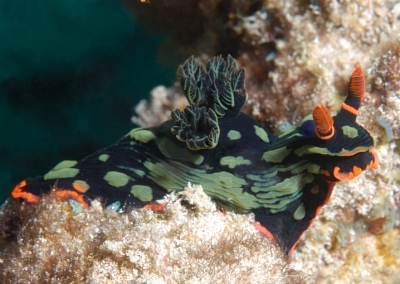
Dear Bill,
While diving in Exmouth in October I came across two Nembrotha's which I thought were different. However I notice that both colour forms are listed as N. kubaryana.
They are chunkier than the ones I used to see in the Solomon Islands, which were much slimmer.
These were both on the same dive site called Cod Spot.
Locality: Exmouth, 12 metres, Western Australia, Indian Ocean, 4 October 2007, Rocky reef. Length: 45mm. Photographer: Bruce Potter.
Bruce Potter
bandppotter@bigpond.com
Potter, B., 2008 (Apr 3) Nembrotha kubaryana from Exmouth, Western Australia. [Message in] Sea Slug Forum. Australian Museum, Sydney. Available from http://www.seaslugforum.net/find/20987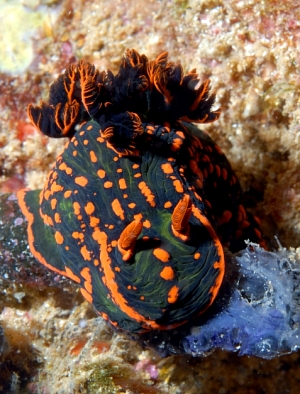
Thanks Bruce,
Best wishes,
Bill Rudman
Re: Is Nembrotha kubaryana no more?
March 2, 2008
From: Kathe R. Jensen
Concerning message #21404:
Dear Bill & Kristin,
I haven't seen the new paper yet, but I will venture a guess that Pola et al. chose Nembrotha nigerrima because Bergh's type specimen exists, and I think probably Lucas has examined it.
Greetings,
Kathe
krjensen@snm.ku.dk
Jensen, K.R., 2008 (Mar 2) Re: Is Nembrotha kubaryana no more?. [Message in] Sea Slug Forum. Australian Museum, Sydney. Available from http://www.seaslugforum.net/find/21415Dear Kathe,
Thanks for commenting. As you will see from Terry's message [#21417] this is more a nomenclatural 'quasi-legal' matter than a matter of 'science'. The Code does have recommendations to guide us when we are making nomenclatural decisions, but it would be impractical to make those recommendations into binding rules. I guess we should be happy that on the whole taxonomists realise the value of the the Rules and do their best to follow them. At times we all make small mistakes. I certainly don't agree with every aspect of the International Code but as this case illustrates, it is better to have a set of rules which allows us to reach agreement quickly when a problem arises than to spend a decade arguing over whether we should use N. kubaryana or N. nigerrima.
Best wishes,
Bill Rudman
Re: Nembrotha kubaryana or Nembrotha nigerrima?
March 2, 2008
From: Terry Gosliner
Concerning message #21407:
Dear Bill,
After reading your message on the Forum, you may have misunderstood what we meant when we said that Nathalie had no grounds for synonymizing N. kubaryana and N. nigerrima. What we were trying to point out, was that she did not examine any specimens of both lined and spotted forms on which to base her assertion. As you point out, we all agree that there are two names for a single species. After re-reading the code, we agree that you are correct in stating that Nathalie was the first reviser and chose the name N. kubaryana as the senior synonym. Therefore, the name needs to be N. kubaryana and not N. nigerrima.
Thanks for pointing this out.
Best,
Marta, Lucas and Terry
tgosliner@calacademy.org
Gosliner, T., 2008 (Mar 2) Re: Nembrotha kubaryana or Nembrotha nigerrima?. [Message in] Sea Slug Forum. Australian Museum, Sydney. Available from http://www.seaslugforum.net/find/21417Dear Terry, Marta and Lucas
I quite agree that Nathalie had little evidence on which to to base her synonymy, but as she did, and chose to use N. kubaryana in preference to N. nigerrima, then the International Code gives us no alternative but to follow her choice.
Best wishes,
Bill Rudman
Re: Nembrotha kubaryana or Nembrotha nigerrima?
February 29, 2008
From: Bill Rudman
Concerning message #21404:
In the course of preparing a new Fact Sheet for N. nigerimma I was reading Pola, Cervera & Gosliner (2008) on synonymising Nembrotha kubaryana and N. nigerrima and was puzzled by their argument that Yonow had no grounds for discarding N. nigerrima as the senior synonym. My understanding was that as both names were published simultaneously. neither was senior to the other. On reflection I think we should continue to use N. kubaryana.
Firstly we all agree that both names refer to the same species, and we all agree that Nathalie Yonow (1991) formally synonymised the two names (if very briefly) and in her act of synonymy gave priority to N. kubaryana. Usually deciding which of two names has priority is simple because under the International Rules the earliest available name has precedence. However in this case both names were in the same publication, N. nigerrima on pages 451-454 and N. kubaryana on page 454. Although Bergh's description of N. kubaryana was poor, he certainly differentiated it from N. nigerrima. So which name has seniority? Under Article 24 of the International Code [see ICZN website for online copy] in cases where names 'are published on the same date in the same or different works, the precedence of the names or acts is fixed by the First Reviser'. In this case Yonow (1991) is the 'first reviser' and she decided to use N. kubaryana. I don't think we have any grounds under the International Rules to reject that decision.
O'Donoghue's earlier decision (1924) to designate N. nigerrima as the type of Nembrotha does not give the name any 'higher' or 'protected' status over N. kubaryana. He certainly was not making a decision about the status of the two species names. Junior synonyms often end up as types of genera but that doesn't matter as long as we are able to identify them.
I would be interested to know what others think of this matter? Am I missing something? Please don't leave me with a deafening silence.
- O'Donoghue, C. H. (1924) Report on Opisthobranchiata from the Abrolhos Islands, Western Australia, with description of a new parasitic copepod. Journal of the Linnean Society, London 35: 521-579, Pls.27-30.
- Pola, M., Cervera, J.L. and Gosliner, T.M. 2008. Revision of the Indo-Pacific genus Nembrotha (Nudibranchia: Dorididae: Polyceridae), with description of two new species. Scientia Marina 72(1): 145-183.
-
Yonow, N. & Hayward, P.J. (1991) Opisthobranches de l'Ile Maurice, avec la description de deux especes nouvelles (Mollusca: Opisthobranchia). Revue francaise d'aquariologie, 18(1): 1-30, Figs 1-13.
Best wishes,
Bill Rudman
Is Nembrotha kubaryana no more?
February 29, 2008
From: Kristin Anderson
Concerning message #15886:
I just received an email from another nudibranch site stating that Nembrotha kubaryana has now been renamed Nembrotha nigerrima, but there was no further information.
Kristin Anderson
kristin@oceansbyanderson.com
Anderson, K. J., 2008 (Feb 29) Is Nembrotha kubaryana no more?. [Message in] Sea Slug Forum. Australian Museum, Sydney. Available from http://www.seaslugforum.net/find/21404Dear Kristin,
That was very quick. I just received a pdf of the relevant paper yesterday and note that the publication date is given as March 2008 which starts tomorrow! In it the authors show that the green-lined N. nigerrima and the green-spotted N. kubaryana are colour forms of the same species. Both were described in the same paper from the same locality. For some reason N. kubaryana has become the most commonly used name. As you will see on the Forum there seem to be many colour forms. The authors have decided that since N. nigerrima was the only one of the two species properly described and illustrated it should be the valid name. Although I have been using N. kubaryana for all colour forms on the Forum I am happy to start using N. nigerrima instead.
Hopefully I will make these changes later today but as there are other changes I will need to make because of the paper it may take a little longer.
PS: Note to all participants: When any of you refer to to other sites or books in your message to the Forum could you please give me a url for the website and a full citation for the book so I can have a look myself and/or include it in your posted message. It would save me so much time .
-
Pola, M., Cervera, J.L. and Gosliner, T.M. 2008. Revision of the Indo-Pacific genus Nembrotha (Nudibranchia: Dorididae: Polyceridae), with description of two new species. Scientia Marina 72(1): 145-183.
Best wishes,
Bill Rudman
Re: Nembrotha cristata feeding
August 10, 2007
From: Matt Doggett
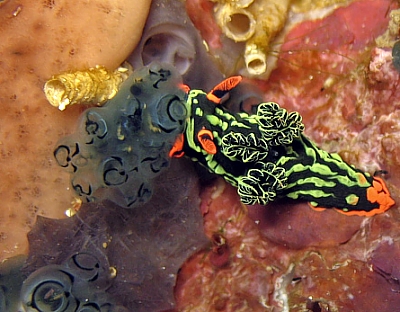
Concerning message #20385:
Thanks Bill
Sorry about ruining your theory!! Here's one that might match your hypothesis of N. kubaryana feeding on a clumped colony of ascidians.
Locality: Apo Island, 10m, Negros Is. , Philippine Sea, November 2006, Fore reef. Length: 3cm. Photographer: Matt Doggett.
Regards
Matt
mattdoggett@hotmail.com
Doggett, M.J., 2007 (Aug 10) Re: Nembrotha cristata feeding. [Message in] Sea Slug Forum. Australian Museum, Sydney. Available from http://www.seaslugforum.net/find/20427Thanks Matt,
Yes this is one of the ascidians we find N. kubaryana feeding on. It's nice to get another observation
Best wishes,
Bill Rudman
Nembrotha kubaryana mating in Sulawesi
May 3, 2007
From: Mike Krampf
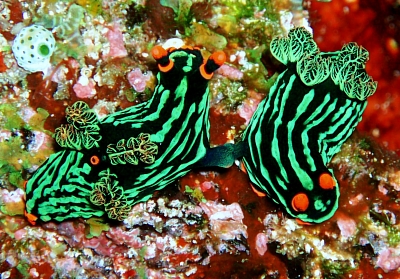
Dear Bill
Here is a picture of Nembrotha kubaryana mating. It was taken at the Lekuan I dive site in Bunaken.
Locality: Dive Site - Lekuan I off Bunaken Island, 55 ft, Sulawesi, Indonesia, Celebes Sea, 21 October 2006, Reef Wall. Length: 4 cm. Photographer: Mike Krampf.
Mike
mtkrampf@yahoo.com
Krampf, M., 2007 (May 3) Nembrotha kubaryana mating in Sulawesi. [Message in] Sea Slug Forum. Australian Museum, Sydney. Available from http://www.seaslugforum.net/find/18636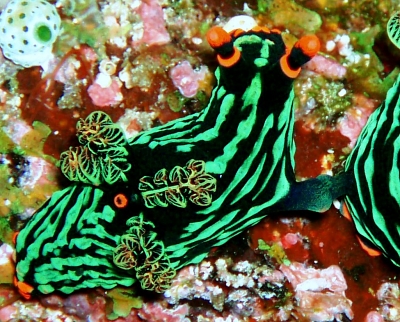
Thanks Mike,
Bill Rudman
Nembrotha kubaryana feeding in the Philippines
April 17, 2007
From: Mike Krampf
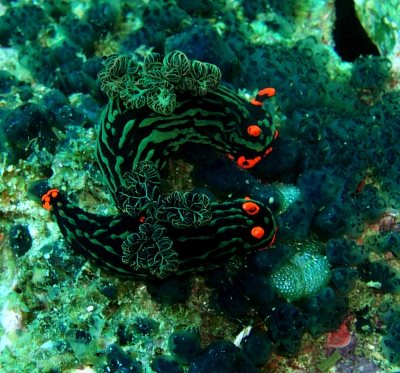
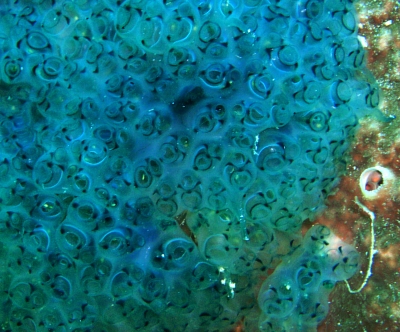
Here is another picture of a Nembrotha kubaryana feeding on an ascidian. There was a Nembrotha convention being held in this area of the reef. There were about a dozen N. kubaryana, a dozen N. cristata and one N. milleri in the area. The ascidian shown was very abundant in the area and while I didn't see either the N. cristata or N. milleri actually feeding they were all situated on or very near the same ascidian.
Locality: Dive Site - Sinandigan Wall, 30 ft, Puerto Galera, Philippines, South China Sea, 22 Feb 2007, Reef. Length: 4-6 cm. Photographer: Mike Krampf.
Cheers,
Mike
mtkrampf@yahoo.com
Krampf, M., 2007 (Apr 17) Nembrotha kubaryana feeding in the Philippines. [Message in] Sea Slug Forum. Australian Museum, Sydney. Available from http://www.seaslugforum.net/find/19564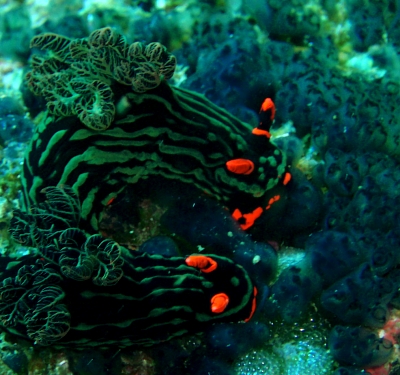
Dear Mike,
Thanks for this interesting observation. Some years ago Prof. Valerie Paul and associates reported on Nembrotha cristata and N. kubaryana feeding on the ascidian Atapozoa sp. Both species removed antifeedant compounds from the ascidian and stored them in their own bodies, exudung them in a slimy mucus when disturbed for their own defence.
I have tentatively identified this ascidian as Sigillina signifera but it is possible I am wrong or that Atapozoa is another name for Sigillina. I need to find an ascidian expert.
-
Paul, V.J., Lindquist, N., Fe n i c a l, W. (1990) Chemical defenses of the tropical ascidian Atapozoa sp. and its nudibranch predators Nembrotha spp. Marine Ecology Progress Series, 59: 109-118
Best wishes,
Bill Rudman
Nembrotha kubaryana from Bunaken, Indonesia
February 14, 2007
From: J.R. Pahlano Daud
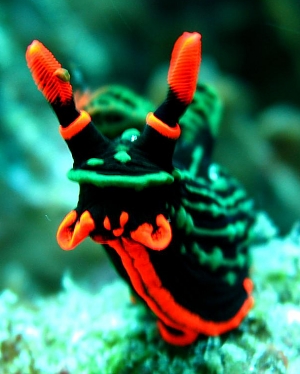
Concerning message #2749:
I took this photo of Nembrotha kubaryana at 5 meters depth in the Reef Edge, Bunaken island, North Sulawesi.
Locality: Manado, 5 m, Indonesia, Pasific Ocean, 08 November 2006, Reef Edge. Length: 6 cm. Photographer: JR Pahlano Daud.
J.R. Pahlano Daud
pahlanoo@yahoo.com
Daud, J.R.P., 2007 (Feb 14) Nembrotha kubaryana from Bunaken, Indonesia. [Message in] Sea Slug Forum. Australian Museum, Sydney. Available from http://www.seaslugforum.net/find/19441Dear Jusak,
Thanks for the photo of this spectacular species. Your photo shows the pair of half-tube shaped oral tentacles very clearly.
Best wishes,
Bill Rudman
Nembrotha kubaryana from the Great Barrier Reef
June 28, 2006
From: Paul Scrobohaci
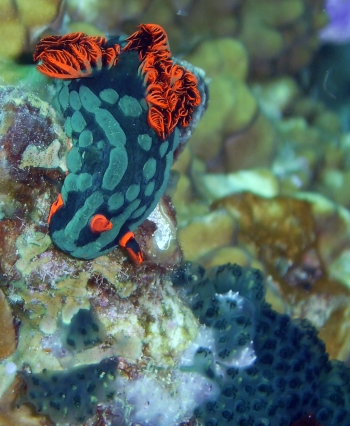
Hello,
I shot this on Steve's Bommie, Great Barrier Reef this April 2006. To my (uneducated) eye it looked like a FAM Polyceridae SUBFAM Nembrothinae or a Chromodorididae.
I looked at all the specimens in those families/subfamilies on your site and could not find it. Could please help id it ?
Locality: Steve's Bommie/Great Barrier Reef, 10 meters, New South Wales, Australia, West Pacific/Corral Sea, 10 April 2006. Length: 30 mm. Photographer: Paul Scrobohaci.
Best Regards,
Paul Scrobohaci
paul_scrobohaci@yahoo.com
Scrobohaci, P.G., 2006 (Jun 28) Nembrotha kubaryana from the Great Barrier Reef. [Message in] Sea Slug Forum. Australian Museum, Sydney. Available from http://www.seaslugforum.net/find/17005Dear Paul,
It is a species of Nembrotha, N. kubaryana, which is quite variable in colour so trying to find an exact match to a photo on the Forum is quite difficult for this species. Your looks quite like another one from the Gt Barrier Reef in Rob Thyer's recent message #16869.
The green mass on the rock below the nudibranch looks very like the preferred food of this species, the ascidian Sigillina signifera.
Best wishes,
Bill Rudman
Nembrotha kubaryana from the Great Barrier Reef
June 16, 2006
From: Robert Thyer
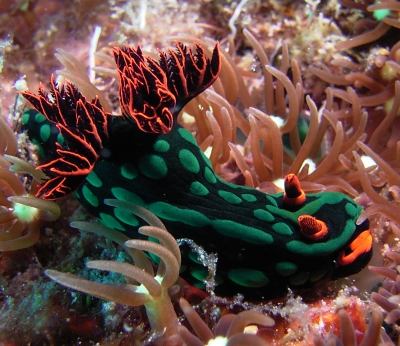
Dear Bill,
I photographed this nudibranch on the Great Barrier Reef last October. Would you please give me its common and scientific names. Thanks.
Locality: Steve's Bommie, Great Barrier Reef, 8-12 m, Queensland, Australia, Pacific Ocean, 28 October 2005, Coral reef. Length: 2.5 - 3 cm. Photographer: Rob Thyer.
Regards
Rob Thyer
robthyer@hotmail.com
Thyer, R.J., 2006 (Jun 16) Nembrotha kubaryana from the Great Barrier Reef. [Message in] Sea Slug Forum. Australian Museum, Sydney. Available from http://www.seaslugforum.net/find/16869Dear Rob,
This is one of the colour variations of Nembrotha kubaryana. Have a look at the species Fact Sheet and earlier messages for further information. Concerning 'common names'; have a look at the Fact Sheet on that topic where you will see I am not in favour of most common names, because they are made up inventions which are seldom in common use.
Like most nudibranchs, there is no common name for Nembrotha kubaryana. You will find so-called 'common names' in various colour photo books, but these are invented at the insistence of book publishers who seem to have the insulting view that their readers are too unintelligent to use scientific names.
Best wishes,
Bill Rudman
Deformed Nembrotha kubaryana
May 31, 2006
From: Ho Wei Kwok Alvin
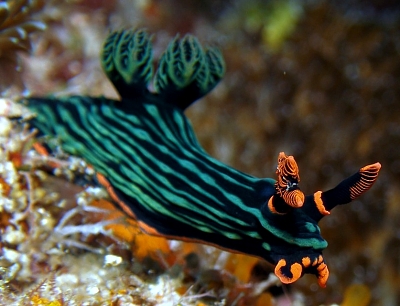
Hi Bill,
Took this photo of a deformed Nembrotha kubaryana with one of it's rhinopores that appears to have branched into three. It was at a site called Teluk Teluran on Pulau Aur.
Locality: Pulau Aur, 10 m, West Malaysia, South China Sea, 12 May 2006, Coral reef. Length: 40 mm. Photographer: Alvin Ho.
Regards,
Alvin
howeikwok@hotmail.com
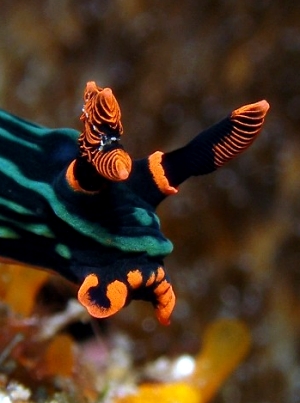
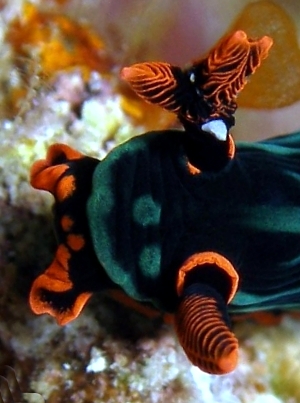
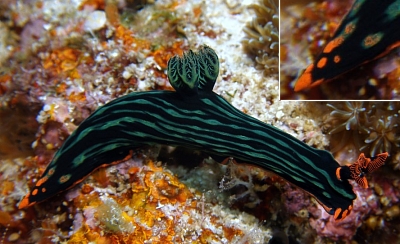
Dear Alvin,
Thanks for the record for the abnormal page. Your photos also show the oral tentacles very well. This species shows how the cylindrical oral tentacles of Roboastra and some species of Tambja, such as T. tentaculata, could have veolved from the flattened ridge found in most species of Nembrotha and Tambja. Your animal also has some orange spotting on the tail, which is a nice linke to the orange-spotted from of this species.
Best wishes,
Bill Rudman
More N. kubaryana & Roboastra
February 23, 2006
From: Kristin Anderson
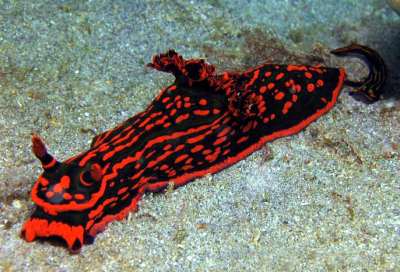
These recent messages prompted me to dig through some more old photographs. I hope they are interesting.
I wish I knew then what I know now and I would have hung out with these two longer!
The small Roboastra luteolineata (? R. gracilis, I'm a bit confused now!) was hot on the trail of this much larger red variation of Nembrotha kubaryana. I spent six or so minutes with them, but the little one fell off the pace and I left.
I've included photos of the predator tracking the sand trail left behind by the Nembrotha kubaryana - not sure if he really does that or if it just appeared that way. He did follow the trail up and around and back out across the sand - I just don't have a whole series.
Locality: Blizzard Ridge, Lighthouse Bay, 14m, Western Australia, Indian Ocean, Ningaloo Reef, 13 January 2005, limestone and hard coral reef. Length: Nembrotha 6-7 cms; Roboastra 2-3 cms. Photographer: Kristin Anderson.
Kristin Anderson
kristin@OceansByAnderson.com
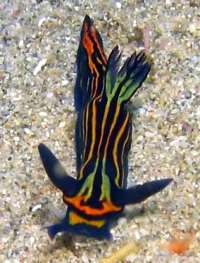
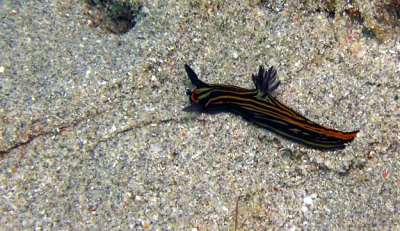
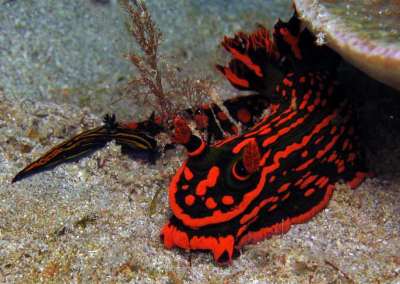
Dear Kristin,
Firstly, the Roboastra is clearly R. luteolineata in this instance. The one in your earlier message [#15816], mentioned by Rie Nakano [#15851], is a problem, because of the angle it is photographed in and because it is at rest, so we have no idea whether its gills and rhinophores are very long, which is a good character of R. gracilis, when all else fails.
Nudibranchs, and other opisthobranchs for that matter certainly follow mucous trails in pursuit of mates and food. The cephalaspid, Navanax inermis, is a good example of a hunter following the trail of its prey, and the many species mentioned on the trailing Fact Sheet illustrate how trail following is used for more sociable behaviour as well.
Best wishes,
Bill Rudman
Re: Nembrotha kubaryana & another species mating?
February 21, 2006
From: Bill Rudman
Concerning message #15886:
On reflection, I think the yellow animal may in fact be Roboastra luteolineata - which would mean that feeding is what we may be witnessing rather than mating. I think the angle of the gills makes their colour pattern look unusual for that species, but when you think of it, it is the most obvious identification. Why are the reproductive organs everted? This is exactly what we saw - and I discussed - in an earlier message [#15757 ] of these two species feeding and being eaten.
Bill Rudman
Rudman, W.B., 2006 (Feb 21) Re: Nembrotha kubaryana & another species mating?. [Message in] Sea Slug Forum. Australian Museum, Sydney. Available from http://www.seaslugforum.net/find/15917Why the white on Nembrotha kubaryana?
February 21, 2006
From: Kristin Anderson
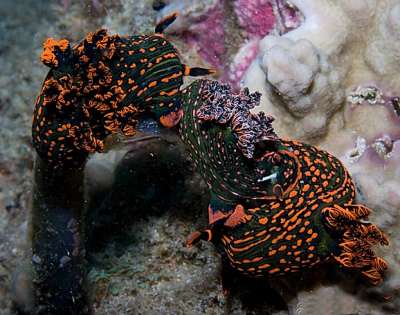
Here's another photo of some Nembrotha kubaryana. When I first saw this guy's head I thought maybe a predator had gotten to him, but when I took the time to look at his gills I started to wonder why this one has all this white. I haven't seen another with this detail.
As you can infer, these guys are plentiful (and it looks like more on the way!) here.
Locality: Lighthouse Bay, 13m, Western Australia, Indian Ocean, Ningaloo Reef, 04 January 2006, hard coral & limestone reef. Length: 3-5cms. Photographer: Kristin Anderson.
Kristin Anderson
kristin@OceansByAnderson.com
Anderson, K.J., 2006 (Feb 21) Why the white on Nembrotha kubaryana?. [Message in] Sea Slug Forum. Australian Museum, Sydney. Available from http://www.seaslugforum.net/find/15894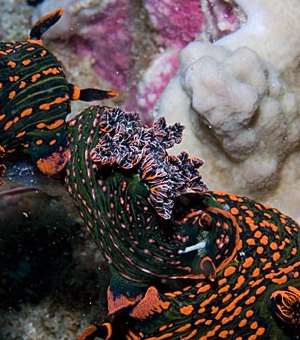
Dear Kristin,
It's possible the one with all the white is just a colour variation, but I suspect the white is from defensive secretions. Species of Nembrotha, and related genera, have small glands arranged in the skin, which exude pigmented secretions which are usually white or yellow. In most species the longitudinal colour bands down the body hide deep grooves which contain lines of these glands. Also the gills have these glands along the edge of the branches and lamellae.
Perhaps this animal is feeling harassed by the other two, since they seem to all be fighting over the same stalked ascidian.
Best wishes,
Bill Rudman
Nembrotha kubaryana & another species mating?
February 21, 2006
From: Kristin Anderson
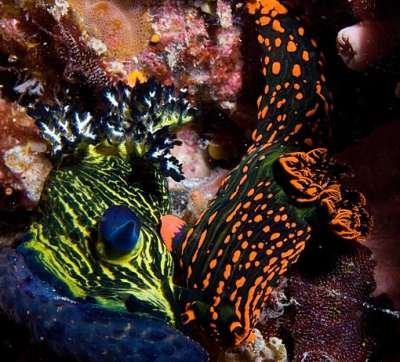
Are these both Nembrotha kubaryana?
They moved together but I missed the actual mating when they had their bits connected - this is the best photo I took with their bits exposed.
Locality: Lighthouse Bay, Ningaloo Reef, 12m, Western Australia, Indian Ocean, January 2006, hard coral & limestone reef. Length: 5-7 cm. Photographer: Kristin Anderson.
Kristin Anderson
kristin@OceansByAnderson.com
Anderson, K.J., 2006 (Feb 21) Nembrotha kubaryana & another species mating?. [Message in] Sea Slug Forum. Australian Museum, Sydney. Available from http://www.seaslugforum.net/find/15886Dear Kristin,
I suspect the yellowish one is there because of the blue ascidian. I wouldn't be surprised if the blue in it was related to the blue colour of the ascidian. I am sure it is not N. kubaryana. There is no sign of orange, and the gills are coloured in a quite different way. The only nembrothid it looks anything like is Roboastra leonis, which is from a different ocean. Certainly the partly everted reproductive organs are suggestive of a relationship between the two, but I suspect the chemical signalling between species of nembrothid may need fine tuning, or perhaps there are different levels of attraction, produced by different chemicals in the pre mating foreplay - perhaps a 'family chemical' as stage 1, and then a species specific chemical as stage 2.
Concerning the identity of the yellow animal - I have no idea.
Best wishes,
Bill Rudman
2 Colour variants of N. kubaryana mating
February 18, 2006
From: Ross Gudgeon
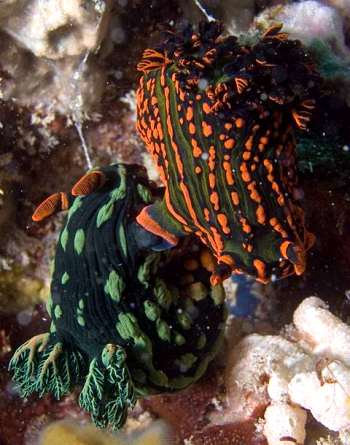
I thought you might be interested in this shot of two different colour variations of Nembrotha kubaryana mating. This shot was taken at the same location as recent shots by myself and Kristin Anderson of N. kubaryana being eaten by various Roboastra species.
Locality: Lighthouse Bay, Exmouth, 12 metres, Western Australia, Indian Ocean, 17 December 2005, Limestone Reef. Length: 50 mm. Photographer: Ross Gudgeon.
Ross Gudgeon
ross@gudgeon.id.au
Gudgeon, R.I., 2006 (Feb 18) 2 Colour variants of N. kubaryana mating. [Message in] Sea Slug Forum. Australian Museum, Sydney. Available from http://www.seaslugforum.net/find/15853Dear Ross,
Thanks for this. It is always good to get confirmation that some of these extreme colour forms are what we think they are.
Best wishes,
Bill Rudman
Nembrotha kubaryana - Exmouth, Australia
August 1, 2005
From: Mick Tait
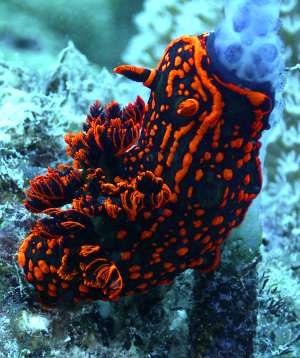
Bill,
Can you please confirm the identification of this species as Nembrotha kubaryana? I have conflicting information to work with. I have a book that identifies this as Nembrotha nigerrima Bergh, 1877. I did a search on Nembrotha nigerrima on the Forum, with nil result. Thank you in advance.
Locality: Lighthouse Bay - Exmouth, Western Australia, Indian Ocean. Depth: 12 m. Length: 50 mm. 02 May 2005. Reef. Photographer: Mick Tait
Mick Tait
mick@bluesphere.com.au
Tait, M., 2005 (Aug 1) Nembrotha kubaryana - Exmouth, Australia. [Message in] Sea Slug Forum. Australian Museum, Sydney. Available from http://www.seaslugforum.net/find/14297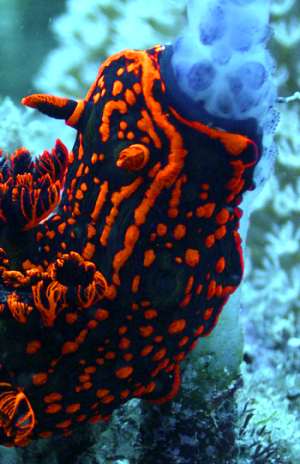
Dear Mick,
I was going to include synonyms for each species - that is names now considered invalid - but it's seldom simple. While in simple cases, such as Nembrotha nigerrima, the name just applies to a colour form of N. kubaryana. However sometimes through confusion, a name has been use for more than one species, so I would need to explain the various misuses. While this would be valuable, I would need to find some volunteers to do it, as it would be a very big job.
Concerning N. kubaryana. At present we consider the species ranges in colour form from green pustules to orange-red pustules. In all cases there is an orange tp orange-red border to the foot and around the rhinophore pockets. The rhinophore has a similar colored tip.
In your photo, the animal seems to be feeding on a stalked colony, which could well be a species of the ascidian Sigillina, which is reported to be its preferred prey. If so, the colony seems to be lot larger than those previously illustrated in Forum messages.
Best wishes,
Bill Rudman
Nembrotha kubaryana from Malaysia
October 2, 2003
From: Asther M. Lau
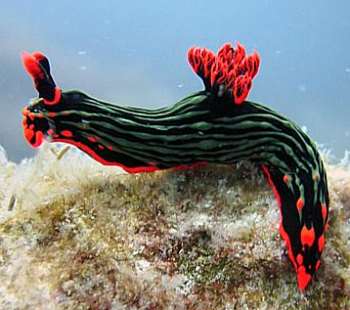
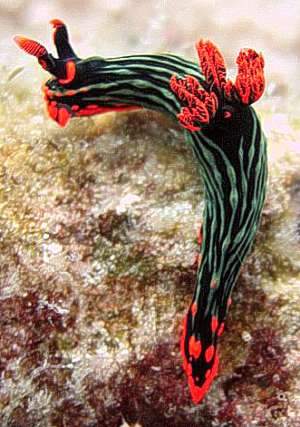
Dear Bill,
This is another sample of Nembrotha kubaryana. I am really proud of the quality and pose of the little thing.
It was crawling lazily on a rock amidst the hard corals all around the site.
Site: Rajawali Wall, Tenggol Is. Malaysia
Date: June 6th 2003
Depth: 9 meters
Regards,
Asther
diveworldwide@yahoo.com
Lau, A.M., 2003 (Oct 2) Nembrotha kubaryana from Malaysia. [Message in] Sea Slug Forum. Australian Museum, Sydney. Available from http://www.seaslugforum.net/find/11045Nice photos Asther,
Bill Rudman
Nembrotha kubaryana - feeding
September 3, 2003
From: Asther M. Lau
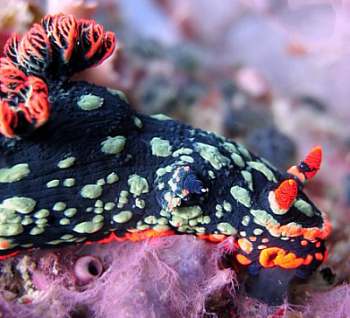
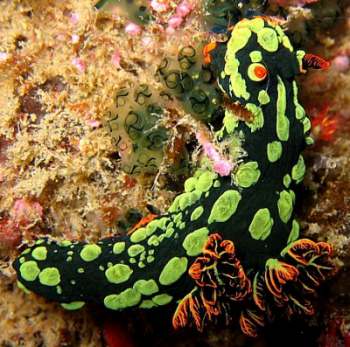
Dear Bill,
During my dive at Labas Is. among its fantastic swimthroughs and boulders, I found these Nembrotha kubaryana (at different spots) eating. It's like a N. kubaryana boom there! And all of them busy eating this weird white thing.
Site: Labas Is., Tioman Malaysia
Date: 10th August 2003
Depth: Between 10 meter (upper pic) to 12 meter (other pics)
Size: Averaging 4.5 cm
Hope these specimens are helpful for your research.
Asther M. Lau
diveworldwide@yahoo.com
Lau, A.M., 2003 (Sep 3) Nembrotha kubaryana - feeding. [Message in] Sea Slug Forum. Australian Museum, Sydney. Available from http://www.seaslugforum.net/find/10875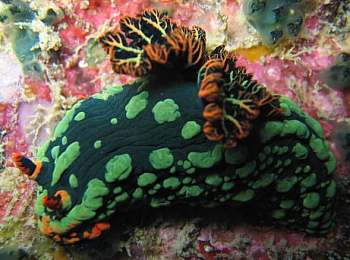
Dear Asther,
Nembrotha kubaryana feeds on the pale transparent greenish ascidian (sea squirt) you can see clearly in the lower two photos. It has a thin dark green edge to its inhalent and exhalent siphons which direct the sea water in and out. Although the one n the top photo seems to be eating the pinkish sponge, I guess it is just crawling over it
Best wishes,
Bill Rudman
Nembrotha kubaryana from the Solomon Ids
July 11, 2003
From: Bruce Potter
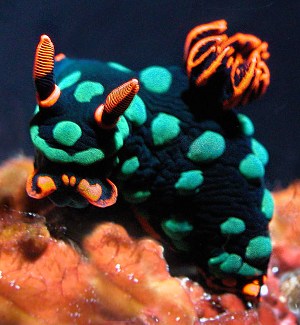
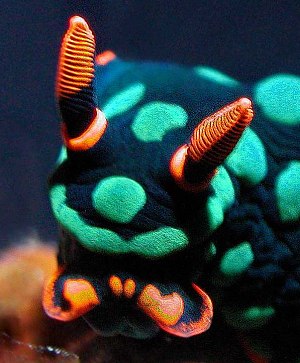
Dear Bill,
Here is a Nembrotha kubaryana from the dive site, Velvia, in the Florida group of the Solomon Islands.
This is common on Velvia, and seen almost nowhere else in Solomons. It was in about 14 meters depth, and was about 25mm long.
Regards,
Bruce Potter
bruce.potter@adventist.org.sb
Potter, B., 2003 (Jul 11) Nembrotha kubaryana from the Solomon Ids. [Message in] Sea Slug Forum. Australian Museum, Sydney. Available from http://www.seaslugforum.net/find/10263Thanks Bruce,
I assume its presence is related to the ascidians that it feeds on
Best wishes,
Bill Rudman
PS: I think this email address no longer works but I have lost your new address. Can you let me know what it is please - Bill
Nembrotha kubaryana from Malaysia
February 7, 2003
From: Kelvin Tan
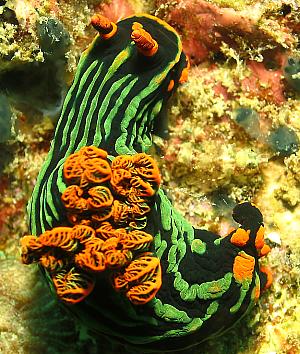
I could not find the scientific names for this sea slug and I would greatly appreciate your expertise in identifying it. I am starting a collection of nudis that I take underwater and sometimes I do not know the name for them. This is a start for me. hope you can help.
Image Data: Tioman, Malaysia. August 2002
Greatly appreciated.
Kelvin Tan
lanxx@pacific.net.sg
Tan, K., 2003 (Feb 7) Nembrotha kubaryana from Malaysia. [Message in] Sea Slug Forum. Australian Museum, Sydney. Available from http://www.seaslugforum.net/find/9125Dear Kelvin,
Good Luck with your photo collection. What we need is more information on the biology and natural history of sea slugs, so photographs of them 'doing things' - such as feeding, mating, and laying eggs - would be very valuable for 'science'. So if you would like an extra challenge any such photos would be very welcome.
Before I overwhelm you with my propaganda, your animal is Nembrotha kubaryana. If you look at the other messages about this species, on the page, you will get an idea of its colour variability and of what we know about its natural history.
Best wishes,
Bill Rudman
Nembrotha kubaryana from Mauritius
November 14, 2002
From: Marina Poddubetskaia
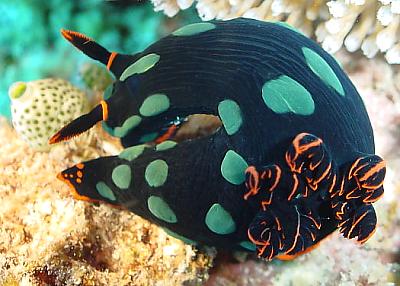
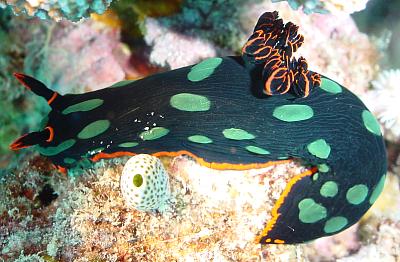
Dear Bill,
Here are some photos of my dear Nembrotha kubaryana from Mauritius. This species can be seen everywhere in the Bay of Pereybere and in large numbers. The local diving guide said he has never seen so many specimens of this species before. This year seems particular.
I have added a shot of a juvenile in a separate message to show that it looks like an adult.
Date: October 14, 2002
Location: Pereybere, Mauritius, Indian Ocean
Site: Anemone Garden
Depth: 16m. Size: 105-110mm
Photos: Marina Poddubetskaia - Nembro website
Best wishes,
Marina.
nembro@nembro.info
Poddubetskaia, M., 2002 (Nov 14) Nembrotha kubaryana from Mauritius. [Message in] Sea Slug Forum. Australian Museum, Sydney. Available from http://www.seaslugforum.net/find/8342Thanks Marina,
Bill Rudman
Juvenile Nembrotha kubaryana from Mauritius
November 14, 2002
From: Marina Poddubetskaia
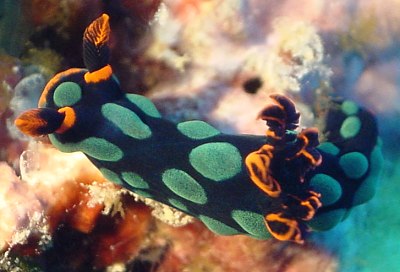
Dear Bill,
To accompany my earlier photos of some adult Nembrotha kubaryana from Mauritius, here is one of a juvenile. This species could be seen everywhere in the Bay of Pereybere and in large numbers. The juvenile looks just like an adult.
Pereybere, Mauritius, Indian Ocean. Site: Grand Aquarium. Depth: 11m. Size: 12-15mm. October 17, 2002. Photos: Marina Poddubetskaia - Nembro website
Best wishes,
Marina.
nembro@nembro.info
Poddubetskaia, M., 2002 (Nov 14) Juvenile Nembrotha kubaryana from Mauritius. [Message in] Sea Slug Forum. Australian Museum, Sydney. Available from http://www.seaslugforum.net/find/8374Thanks Marina,
It is interesting to see just how large and rounded the green spots are in juveniles. It is certainly very useful to get photos of juveniles.
Best wishes,
Bill Rudman
Nembrotha kubaryana feeding
November 7, 2002
From: Sabine Noack

Dear Bill,
Here is another photo of a feeding sea slug: Nembrotha kubaryana (orange border is visible at the end of the foot) sitting and feeding in a nest of her favourite ascidians.
Location: Cannibal Rock, Horseshoe Bay, Rinca, Indonesia
Depth: ~25m
Date/Time: 1.10.2001, 9:22
Size: ~6cm
Sabine
dive@snoack.de
Noack, S., 2002 (Nov 7) Nembrotha kubaryana feeding. [Message in] Sea Slug Forum. Australian Museum, Sydney. Available from http://www.seaslugforum.net/find/8289Thanks Sabine,
With your photo, and Nishina's, and earlier messages, we are starting to build up good evidence that Sigillina is a favoured food of this spsecies.
Best wishes,
Bill Rudman
Nembrotha kubaryana from North Sulawesi
October 14, 2002
From: Marli Wakeling
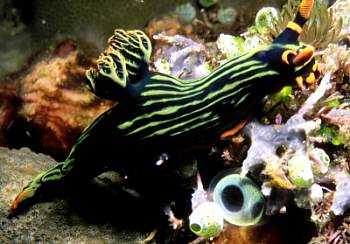
Ho Bill,
Here is Nembrotha kubaryana from Lembeh Straight,North Sulawesi. It was crawling on a coral head with lots of tunicates and hydroids around it.
Location: Batu merah, Lembeh Straight, Sulawesi, Indonesia
Date: July 2002
Depth: 40 feet
Length: 10 cm.
Photographs: Marli Wakeling
Marli
scubamarli@excite.com
Thanks Marli,
Bill Rudman
Nembrotha kubaryana feeding
September 19, 2002
From: Nishina Masayoshi
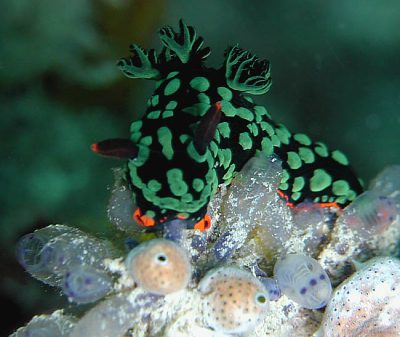
Dear Bill,
Here is Nembrotha kubaryana feeding on some ascidians
Date: 31 May 2000
Location: Mabul island, Borneo Island, Malaysia
Length: 25mm
Depth: 6m
Water temp: 27C degree
Photo: M. Nishina
Best Regards,
Nishina Masayoshi
nishina@wips.co.jp
Masayoshi, N., 2002 (Sep 19) Nembrotha kubaryana feeding. [Message in] Sea Slug Forum. Australian Museum, Sydney. Available from http://www.seaslugforum.net/find/7731Dear Nishina,
Nembrotha kubaryana seems to prefer this ascidian Sigillina.
Bill Rudman
Nembrotha kubaryana from Malaysia
September 7, 2002
From: Richard Houghton
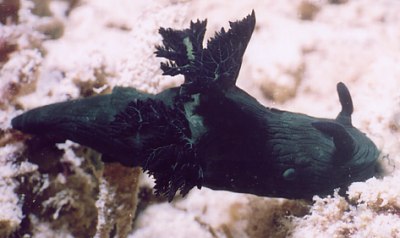
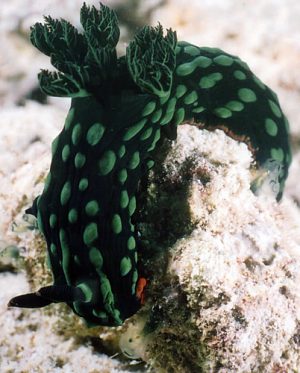
Two different colour schemes of what may be Nembrotha kubaryana (one was entirely green, the other had tell tale red markings). Kapalai Island, Malaysia, August 2002.
Coincidentally, both appear to be eating Tunicates - and both photo's were taken on the same dive, around 11am.
Best regards,
Rich
richard_houghton@hotmail.com
Houghton, R., 2002 (Sep 7) Nembrotha kubaryana from Malaysia. [Message in] Sea Slug Forum. Australian Museum, Sydney. Available from http://www.seaslugforum.net/find/7850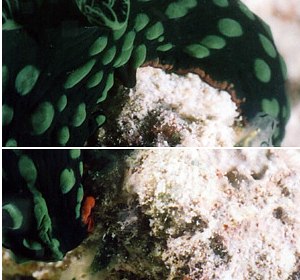
Dear Rich,
The upper photo of the green animal is Nembrotha milleri while the lower one is indeed a colour form of Nembrotha kubaryana. The 'telltale' red on the edge of the foot is certainly a sign of this species but can sometimes, as in this case, be hard to see.
Best wishes,
Bill Rudman.
Nembrotha kubaryana from the Solomon Ids
August 2, 2002
From: Ken Clayton
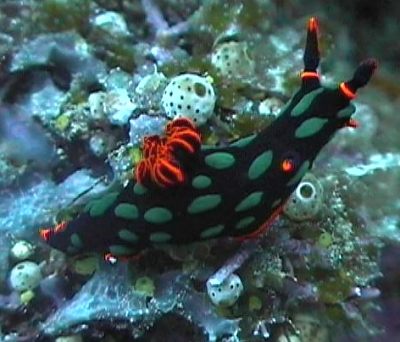
Dear Bill,
Can you identify this slug please?
Solomon Islands, 18m , coral reef , Hard coral, subject to occasional currents, Early June 2002, Estimated length of slug 2cm, active, occasional saw others, not many, daylight.
Ken Clayton
clayray@lavalink.com.au
Clayton, K., 2002 (Aug 2) Nembrotha kubaryana from the Solomon Ids. [Message in] Sea Slug Forum. Australian Museum, Sydney. Available from http://www.seaslugforum.net/find/7640Dear Ken,
This is Nembrotha kubaryana. The pale green ball-shaped objects around the slug are ascidians (sea squirts, tunicates). Species of Nembrotha feed on ascidians, but I don't know if Nembrotha kubaryana has been reported to feed on this species. In an earlier message it is reported to eat Sigillina signifera.
Best wishes,
Bill Rudman
Nembrotha kubaryana? from Malaysia
July 20, 2002
From: Maliza Anuar
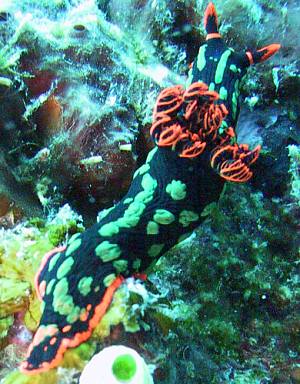
Bill,
This photo was taken at Tioman Island, off the east coast of west Malaysia.
Dive Site: Soyak Island, 23 June 2002, 4:30pm. Depth: 10-12m, Size: 6-7cm
I'm new to identifying nudis, but comparing to your species list, I'm pretty sure this is a Nembrotha kubaryana.
Maliza
emaliza@hotmail.com
Anuar, M., 2002 (Jul 20) Nembrotha kubaryana? from Malaysia. [Message in] Sea Slug Forum. Australian Museum, Sydney. Available from http://www.seaslugforum.net/find/7515Dear Maliza.
Yes this is Nembrotha kubaryana.
Best wishes,
Bill Rudman
Nembrotha kubaryana f rom Indonesia
July 16, 2002
From: Richard Houghton
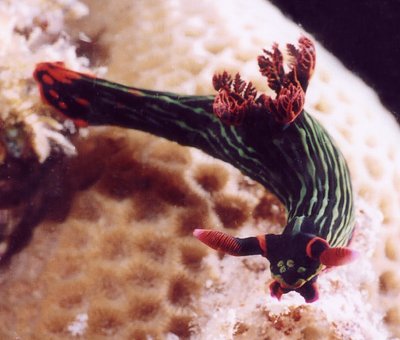
Hi Bill,
Here is what I think is Nembrotha kubaryana which I found in the Anambas islands, Indonesia.
Keep up the excellent work!
Rich
richard_houghton@hotmail.com
Houghton, R., 2002 (Jul 16) Nembrotha kubaryana f rom Indonesia. [Message in] Sea Slug Forum. Australian Museum, Sydney. Available from http://www.seaslugforum.net/find/7467Dear Rich,
Yes this is Nembrotha kubaryana.
Best wishes,
Bill Rudman
Nembrotha kubaryana from nthn Sulawesi
July 13, 2002
From: Helmut Schirmböck
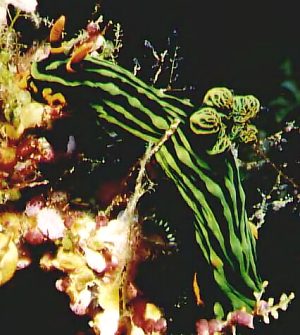
Here is another photo from the Lembeh Strait region of Nth Sulawesi, Indonesia, [April-May, 2002].
Regards,
Helmut.
schirmis@aon.at
Schirmböck, H. , 2002 (Jul 13) Nembrotha kubaryana from nthn Sulawesi. [Message in] Sea Slug Forum. Australian Museum, Sydney. Available from http://www.seaslugforum.net/find/7409Dear Helmut,
This is Nembrotha kubaryana.
Cheers,
Bill Rudman
Nembrotha - preferred ascidians
June 13, 2002
From: Nerida Wilson
Hi Bill,
I also have records of Nembrotha kubaryana feeding on the same ascidian that Erwin reported. It was at Osprey Reef, 10 April 2001, around 5m. Unfortunately I have no photograph. I tentatively identified it as Sigillina signifera from Coral Reef Animals of the Indo-Pacific by Gosliner et al.
Cheers
Nerida
nwilson@marine.uq.edu.au
Wilson, N., 2002 (Jun 13) Nembrotha - preferred ascidians. [Message in] Sea Slug Forum. Australian Museum, Sydney. Available from http://www.seaslugforum.net/find/7238Thanks Nerida,
I think you are right with the identification. In an earlier comment of mine concerning the food of N. milleri, I quote an exchange I had had with Dave Behrens who identified it as Sigillina signifera.
Cheers,
Bill Rudman
Nembrotha kubaryana feeding and mating
June 12, 2002
From: Erwin Köhler
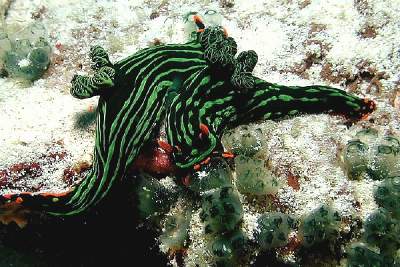
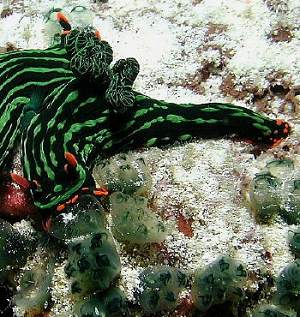
Dear Bill,
In separate messages I sent Nembrotha milleri and Nembrotha cristata from the same dive at the Philippines, Balicasag Island. Here is a pair of Nembrotha kubaryana mating and one of them feeding on some ascidians, nice life - like in old Rome...
Data:
size ~6 cm (I didn't want to disturb them)
depth 16 m
03 March 2002
Erwin
Erwin@medslugs.de
Köhler, E., 2002 (Jun 12) Nembrotha kubaryana feeding and mating. [Message in] Sea Slug Forum. Australian Museum, Sydney. Available from http://www.seaslugforum.net/find/7192Thanks Erwin,
Ancient Rome is definitely a good comparison.
Cheers,
Bill Rudman
Nembrotha kubaryana with third Rhinophore
November 29, 2001
From: Michael D. Miller
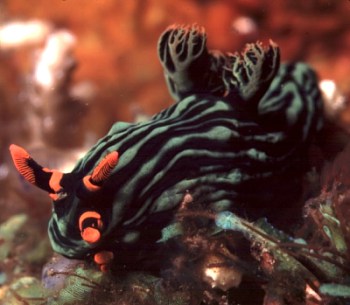
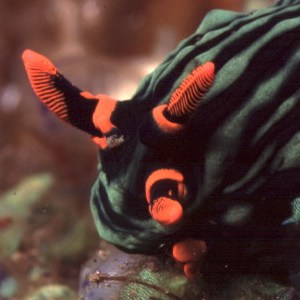
Dear Bill
To add to your list of the strange and bizarre, consider the attached photo
of a Nembrotha kubaryana with a third Rhinophore.
Location: Tulamben, Bali, Indonesia
Depth: 40 ft.
Date: Oct. 2001
Photographer: Michael Miller
Cheers;
Mike Miller
mdmiller@cts.com
Miller, M.D., 2001 (Nov 29) Nembrotha kubaryana with third Rhinophore. [Message in] Sea Slug Forum. Australian Museum, Sydney. Available from http://www.seaslugforum.net/find/5736Thanks Mike,
Compiling this list is proving an interesting exercise. Some abnormalities, like 3 rhinophores, seem to be fairly common in different families.
Best wishes,
Bill Rudman
Nembrotha kubaryana from Exmouth, W.A.
April 10, 2001
From: Kirk Gibson
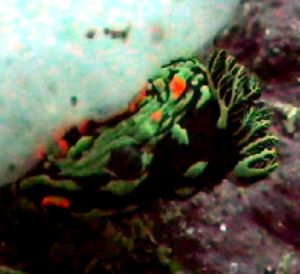
Dear Bill,
Here is another nudibranch from Exmouth, northern Western Australia.
Kirk Gibson
captainkirk@wn.com.au
Gibson, K., 2001 (Apr 10) Nembrotha kubaryana from Exmouth, W.A.. [Message in] Sea Slug Forum. Australian Museum, Sydney. Available from http://www.seaslugforum.net/find/4105Dear Kirk,
I am pretty sure this is Nembrotha kubaryana, which you will see from the other photos and messages on this page, is quite variable in colour. Another very similarly coloured species, Nembrotha cristata lacks the orange markings on the foot and oral lappets, but neither are visible in your photo.
Bill Rudman
Nembrotha kubaryana from Papua New Guinea
September 12, 2000
From: Stuart Hutchison
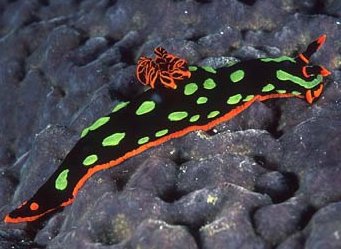
Dear Bill,
Here is Nembrotha kubaryana from Milne Bay, Papua New Guinea. This guy was found at about 10m on a large coral bommie in March 1998. It was about 2.5" long.
This is my favourite nudibranch by far.
Stuart Hutchison
hutchco@tpg.com.au
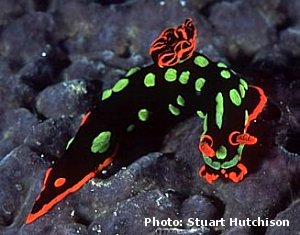
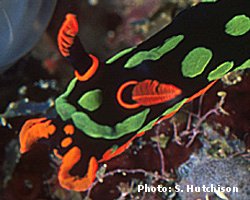
Dear Stuart,
Thanks for the photos.
Bill Rudman.
Colour variation in Nembrotha kubaryana
August 3, 2000
From: Mary Jane Adams
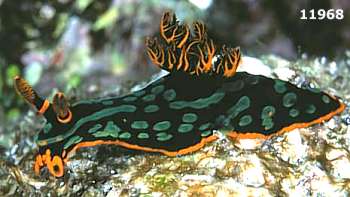
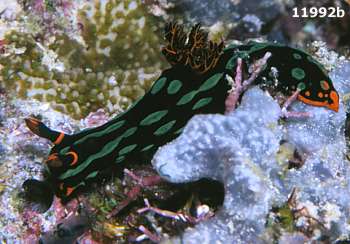
Dear Bill,
Here are pictures of Nembrotha kubaryana from two different coral reefs. I have sent a photo of one from
Ningaloo Reef, near Exmouth, Western Australia in a separate message.
Details:
• 11968 Eastern Fields, 170 km southwest of Port Moresby, Papua New Guinea. Divesite: "Neptune's Garden". Depth: 8 meters. Length: 44mm. November 13, 1996
• 11992b Florida Group, Solomon Islands. Dive site: "Baby Cakes" . Depth: 10 meters. Length: 44mm. November 15, 1999
Photos: Mary Jane Adams.
Best wishes,
Mary Jane Adams
mjadams@earthlink.net
Thanks Mary Jane,
Bill Rudman.
Nembrotha kubaryana from Ningaloo Reef
August 3, 2000
From: Mary Jane Adams
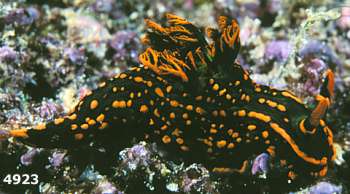
Dear Bill,
Here is a picture of Nembrotha kubaryana from Western Australia to go with the other two I sent in a separate message.
Locality details: Ningaloo Reef, near Exmouth, Western Australia. Depth: 23 meters, Length: 40 mm March 27, 1992. Photo: Mary Jane Adams.
Mary Jane Adams
mjadams@earthlink.net
Adams, M.J., 2000 (Aug 3) Nembrotha kubaryana from Ningaloo Reef. [Message in] Sea Slug Forum. Australian Museum, Sydney. Available from http://www.seaslugforum.net/find/2807Dear Mary Jane,
Thanks again. This species is certainly very variable in colour.
Best wishes,
Bill Rudman.
Nembrotha kubaryana? from Sulawesi
July 24, 2000
From: Lindsay Warren
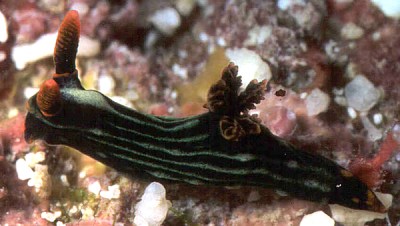
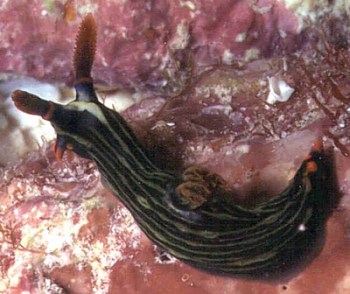
Dear Bill
Both these Nembrothid juveniles were found off Pulau Hoga [Tukang Besi Archipelago, SE Sulawesi, Indonesia - Operation Wallacea] during the 1999 survey season.
UPPER PHOTO: (OS0837) October 1999 on Pulau Hoga, but I have no details as to substrate or depth. Size: 8mm.
LOWER PHOTO: (OS0657) on 3 September 1999 at a depth of 22 ft on dead coral and algae on the reef crest of Pulau Kaledupa [Tukang Besi Archipelago, SE Sulawesi]. Size: 17 mm.
Photos: Lindsay Warren.
The thing that puzzled us was the very obvious blue area on the rhinophore sheaths, oral tentacles, branchial plume pocket and edge of foot. The other marking of note seemed to be the pale green area between the
rhinophores in contrast to the darker green stripes down the body. Given the orange 'coating' to both gills and rhinophores and on a couple of other areas of the body, we thought they would probably be N. kubaryana.
Is this correct?
All the best
Lindsay
alldcl@compuserve.com
Warren, L., 2000 (Jul 24) Nembrotha kubaryana? from Sulawesi. [Message in] Sea Slug Forum. Australian Museum, Sydney. Available from http://www.seaslugforum.net/find/2749Dear Lindsay,
I am pretty sure these are juvenile Nembrotha kubaryana. The strange colours you have noted are probably associated with its size, juveniles of some species, especially when the adult colour is very dark or black, have much more colour in them than adults.
Best wishes,
Bill Rudman.
Nembrotha kubaryana from Lord Howe Island
September 28, 1999
From: Wayne Ellis
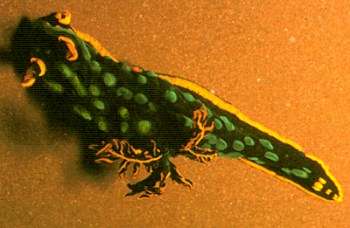
HI Bill,
Attached is an image from the Lord Howe Island Fauna Survey, 1987 I'm not sure about. It was collected in Oct 1987. The survey was organised by Neville Coleman who probably donated some of the specimens to the museum.
Wayne Ellis
glaskin@ozemail.com.au
Ellis, W., 1999 (Sep 28) Nembrotha kubaryana from Lord Howe Island. [Message in] Sea Slug Forum. Australian Museum, Sydney. Available from http://www.seaslugforum.net/find/1375Thanks Wayne,
To those of you who don't know the geography of eastern Australia very well, Lord Howe Island is about 1000k northeast of Sydney in the Tasman Sea, and has some of the most southerly coral reefs. Although the marine fauna has the usual mix of tropical and temperate species, there is also a proportion of species which are endemic to an area bounded by Lord Howe Island, northern New South Wales, and some oceanic reefs off Queensland.
This species is one of the colour forms of the tropical species, Nembrotha kubaryana.
Bill Rudman.
Rudman, W.B., 1999 (Sep 28). Comment on Nembrotha kubaryana from Lord Howe Island by Wayne Ellis. [Message in] Sea Slug Forum. Australian Museum, Sydney. Available from http://www.seaslugforum.net/find/1375Nembrotha kubaryana from Papua New Guinea
July 8, 1999
From: Grey McNeil
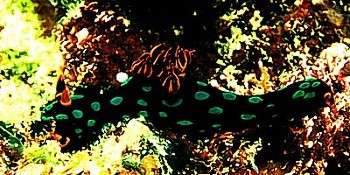
Dear Bill,
Could you identify this photo please. The details are:
HOUSE REEF, JAIS ABEN, Papua New Guinea, 3m, December 1998, 5cm long.
Thanks,
Grey McNeil.
GREYMACIND@bigpond.com
McNeil, G., 1999 (Jul 8) Nembrotha kubaryana from Papua New Guinea. [Message in] Sea Slug Forum. Australian Museum, Sydney. Available from http://www.seaslugforum.net/find/994This is Nembrotha kubaryana. You will find a little about it at the top of the page. It is very similar in colour to Nembrotha cristata which you have sent a photo from the same locality.
Bill Rudman.
Rudman, W.B., 1999 (Jul 8). Comment on Nembrotha kubaryana from Papua New Guinea by Grey McNeil. [Message in] Sea Slug Forum. Australian Museum, Sydney. Available from http://www.seaslugforum.net/find/994Nembrotha kubaryana from the Philippines
January 21, 1999
From: Erwin Koehler
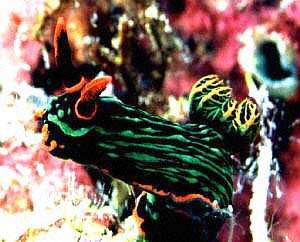
Bill,
Here is Nembrotha kubaryana (Bergh, 1877), Housereef, Panglao Is., Philippines, Nov. 1998
Erwin
E.Koehler@deutschepost.de
Koehler, E., 1999 (Jan 21) Nembrotha kubaryana from the Philippines. [Message in] Sea Slug Forum. Australian Museum, Sydney. Available from http://www.seaslugforum.net/find/494